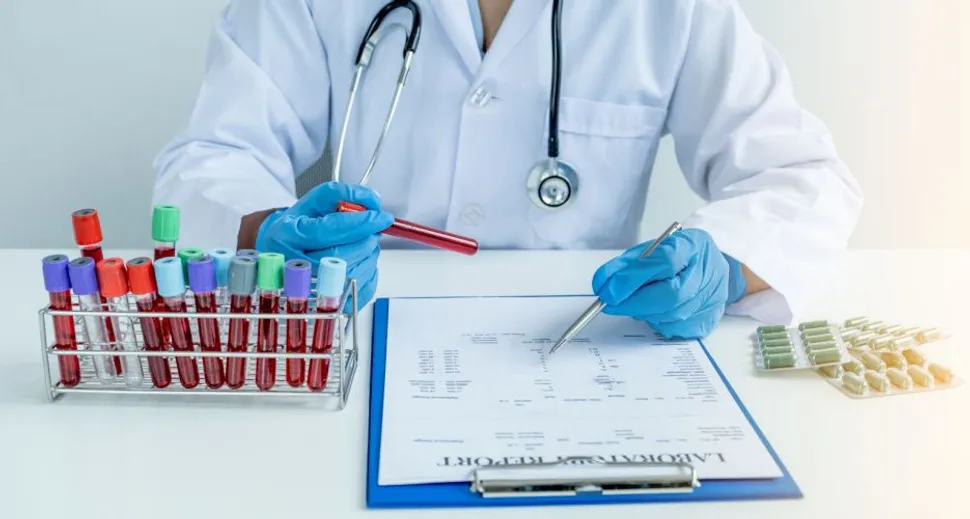Understanding Your Labs

Understanding Your Labs
Improving your understanding of myelodysplastic syndromes can enhance your communication with your doctor and empower you to make informed decisions. Understanding the meaning of your lab values is a big thing that can help you keep track of your health. MDS is generally diagnosed when a patient is evaluated for low blood counts, although in some MDS patients, the white blood count, platelet count, or both may be elevated. The hallmark feature of MDS is a bone marrow aspirate and biopsy that reveals many abnormal-looking bone marrow cells.
A chromosome analysis, called cytogenetics, is performed on the bone marrow sample. In patients with MDS, immature cells called blasts make up less than 20% of the cells in the bone marrow. If blast cells make up more than 20%, the patient is diagnosed with acute myeloid leukemia. This is important to differentiate because the treatment is key to each and the genetic mutations they may have, known as targeted therapy. There are many lab results to see in an office visit with your doctor, but in this article, we will focus on the bone marrow biopsy and the complete blood count in a simple blood test.
Usually, the complete blood counts include an average count of each circulating blood cell; all blood cells are born in the bone marrow, and this is relevant because this can be an indicator of infection, anemia, low platelets, a prothrombotic state, a compromised immune system or in this case, it can indicate which cell type is occupying the bone marrow and is being overproduced without having the need of a painful procedure like a bone marrow biopsy as a routine test.
Then, why is the bone marrow biopsy necessary? Well, for diagnostic purposes and to plan the treatment and stop the disease, the doctors must know how many and which cells are in the bone marrow. Making the differentiation is important because that way, one can plan the future for diagnosis for treatment, set realistic expectations around the disease, set how often one will visit your doctor, and the best ways to cope with the symptoms.
Blood cells and components analyzed in a complete blood count
| Name | Reference Range | What It Means |
|---|---|---|
| Hemaglobin (HGB) | 12.1-15.9 g/dL | HGB is the protein that carries oxygen in the red blood cells. When it is below the normal range It indicates anemia, which is a condition characterized by weakness, pallor, reduced ability to exercise, shortness of breath and dizziness. If the Hemaglobin is low, less than 7.5 G/dL, many doctors will give patients a blood transfusion until the patient no longer exhibits symptoms. If it is less than 9%, Aranesp injections are som etimes used to stimulate red blood cell production. |
| Red Blood Cells/Erythrocyte (RBC) | 3.88-5.46 1012/L | Low RBC counts indicate anemia resulting in fatigue and lowered oxygen transport. Can be a result of bleeding or low RBC production in the bone marrow. |
| Leukocytes/White Blood Cells (WBC) | 3.2-10.6 k/ul | White blood cells are produced in the bone marrow. White blood cell counts include: Neutrophils (also known as granuloytes), Lymphocytes, Monocytes, Eosinophils, and Basophils. Counts are reported two ways: First as a percentage of the total WBC and also as an "absolute count" or an actual number of cells present. Low WBC lowers resistance to infections. High WBC may indicate illness or cancer growth. |
| Platelets (PLT) | 150-440 k/ul | Platelets are produced in the bone marrow. Their primary function is to induce coagulation (clotting) at points of injury. When platelet counts are low, minor scrapes and bruises may cause serious bleeding. |
| Neutrophil/granulocyte (ANC, AGC) | 1.3-7 k/ul absolute count, 44-76% | Neutrophils (granulocytes) are the largest percentage of white blood cells. They are the "soldiers" that help you fight infection. They help to get rid of bad bacterias in your body. Low levels indicate the inability to fight infection. |
| Eosinophils | 0-0.4 k/ul absolute count, 4-8.9% | Eosinophils are elevated in allergic reactions and help to fight certain parasitic infections. |
| Monocytes | 0.2-0.7 k/ul absolute count, 0-1.7% | Monocytes also help your body to fight infections. When they enter the tissues, they fight infection, ingest dead cells and assist in immune responses. |
| Basophils | 0-0.1 k/ul absolute count, 0-1.7% | Basophils also participate in allergic reactions. |
| Lymphocytes | 0.8-3.1 k/ul absolute count, 14.7-42.6% | Lymphocytes are the essential cell type in the immune system. There are three major types of lymphocytes: B lymphocytes that produce antibodies, T lymphocytes that assist in antibody production, and Natural Killer cells (NK) that attack virus-infected cells or tumor cells. |
Bone marrow biopsy Nucleated differential count
A BM nucleated differential cell count (NDC) should be performed to assess haemopoietic activity and to compare the proportions of the different cell lineages with known reference ranges, and also to quantify abnormal cells, if present.
The NDC should be comprised of blast cells, promyelocytes, myelocytes, metamyelocytes, band forms, segmented neutrophils, eosinophils, basophils, mast cells, promonocytes and monocytes, lymphocytes, plasma cells and erythroblasts. These are the “baby” cells, or immature cells that later convert to the mature blood cells that circulate in our veins, but the ones that comprise NDC are only found inside the bone marrow.
The NDC should not include megakaryocytes, macrophages, osteoblasts, osteoclasts, stromal cells, smudged cells or non-haemopoietic cells such as metastatic tumour cells. Lymphoid aggregates, if present, should not be included in the NDC, but their presence should be commented upon.
Now to know the cellullarity, we have to consider that in normal conditions the bone marrow produces blood cells in a small percentage, but with time, the bone marrow converts to fat if it’s not producing or overproducing blood cells, so that means, the normal cellularity of adult hematopoietic bone marrow ranges from 30 to 70%, and this changes under pathological conditions. Hypercellular marrow is defined as more than 70%, normocellular marrow as 30–70%, and hypocellular marrow as under 30% bone marrow.
The distribution of the production of the cells is proportional to the amount of cells that are normally distributed in the blood. This balance could be affected if the bone marrow overproduces a type of cell, like in bacterial infections when granulocytes are elevated, therefore more of them will be produced in the bone marrow. Patients with MDS who produce abnormal cells of one or more cell types end up with crowding in the bone marrow as abnormal cells take up space needed to produce regular cells causing lower production and low blood counts, often resulting in anemia.
How we can help?
If you need assistance understanding your diagnosis or deciphering your labs, please contact our Patient Navigator support team at 1-800-709-1113 or at support@healthtree.org
Understanding Your Labs
Improving your understanding of myelodysplastic syndromes can enhance your communication with your doctor and empower you to make informed decisions. Understanding the meaning of your lab values is a big thing that can help you keep track of your health. MDS is generally diagnosed when a patient is evaluated for low blood counts, although in some MDS patients, the white blood count, platelet count, or both may be elevated. The hallmark feature of MDS is a bone marrow aspirate and biopsy that reveals many abnormal-looking bone marrow cells.
A chromosome analysis, called cytogenetics, is performed on the bone marrow sample. In patients with MDS, immature cells called blasts make up less than 20% of the cells in the bone marrow. If blast cells make up more than 20%, the patient is diagnosed with acute myeloid leukemia. This is important to differentiate because the treatment is key to each and the genetic mutations they may have, known as targeted therapy. There are many lab results to see in an office visit with your doctor, but in this article, we will focus on the bone marrow biopsy and the complete blood count in a simple blood test.
Usually, the complete blood counts include an average count of each circulating blood cell; all blood cells are born in the bone marrow, and this is relevant because this can be an indicator of infection, anemia, low platelets, a prothrombotic state, a compromised immune system or in this case, it can indicate which cell type is occupying the bone marrow and is being overproduced without having the need of a painful procedure like a bone marrow biopsy as a routine test.
Then, why is the bone marrow biopsy necessary? Well, for diagnostic purposes and to plan the treatment and stop the disease, the doctors must know how many and which cells are in the bone marrow. Making the differentiation is important because that way, one can plan the future for diagnosis for treatment, set realistic expectations around the disease, set how often one will visit your doctor, and the best ways to cope with the symptoms.
Blood cells and components analyzed in a complete blood count
| Name | Reference Range | What It Means |
|---|---|---|
| Hemaglobin (HGB) | 12.1-15.9 g/dL | HGB is the protein that carries oxygen in the red blood cells. When it is below the normal range It indicates anemia, which is a condition characterized by weakness, pallor, reduced ability to exercise, shortness of breath and dizziness. If the Hemaglobin is low, less than 7.5 G/dL, many doctors will give patients a blood transfusion until the patient no longer exhibits symptoms. If it is less than 9%, Aranesp injections are som etimes used to stimulate red blood cell production. |
| Red Blood Cells/Erythrocyte (RBC) | 3.88-5.46 1012/L | Low RBC counts indicate anemia resulting in fatigue and lowered oxygen transport. Can be a result of bleeding or low RBC production in the bone marrow. |
| Leukocytes/White Blood Cells (WBC) | 3.2-10.6 k/ul | White blood cells are produced in the bone marrow. White blood cell counts include: Neutrophils (also known as granuloytes), Lymphocytes, Monocytes, Eosinophils, and Basophils. Counts are reported two ways: First as a percentage of the total WBC and also as an "absolute count" or an actual number of cells present. Low WBC lowers resistance to infections. High WBC may indicate illness or cancer growth. |
| Platelets (PLT) | 150-440 k/ul | Platelets are produced in the bone marrow. Their primary function is to induce coagulation (clotting) at points of injury. When platelet counts are low, minor scrapes and bruises may cause serious bleeding. |
| Neutrophil/granulocyte (ANC, AGC) | 1.3-7 k/ul absolute count, 44-76% | Neutrophils (granulocytes) are the largest percentage of white blood cells. They are the "soldiers" that help you fight infection. They help to get rid of bad bacterias in your body. Low levels indicate the inability to fight infection. |
| Eosinophils | 0-0.4 k/ul absolute count, 4-8.9% | Eosinophils are elevated in allergic reactions and help to fight certain parasitic infections. |
| Monocytes | 0.2-0.7 k/ul absolute count, 0-1.7% | Monocytes also help your body to fight infections. When they enter the tissues, they fight infection, ingest dead cells and assist in immune responses. |
| Basophils | 0-0.1 k/ul absolute count, 0-1.7% | Basophils also participate in allergic reactions. |
| Lymphocytes | 0.8-3.1 k/ul absolute count, 14.7-42.6% | Lymphocytes are the essential cell type in the immune system. There are three major types of lymphocytes: B lymphocytes that produce antibodies, T lymphocytes that assist in antibody production, and Natural Killer cells (NK) that attack virus-infected cells or tumor cells. |
Bone marrow biopsy Nucleated differential count
A BM nucleated differential cell count (NDC) should be performed to assess haemopoietic activity and to compare the proportions of the different cell lineages with known reference ranges, and also to quantify abnormal cells, if present.
The NDC should be comprised of blast cells, promyelocytes, myelocytes, metamyelocytes, band forms, segmented neutrophils, eosinophils, basophils, mast cells, promonocytes and monocytes, lymphocytes, plasma cells and erythroblasts. These are the “baby” cells, or immature cells that later convert to the mature blood cells that circulate in our veins, but the ones that comprise NDC are only found inside the bone marrow.
The NDC should not include megakaryocytes, macrophages, osteoblasts, osteoclasts, stromal cells, smudged cells or non-haemopoietic cells such as metastatic tumour cells. Lymphoid aggregates, if present, should not be included in the NDC, but their presence should be commented upon.
Now to know the cellullarity, we have to consider that in normal conditions the bone marrow produces blood cells in a small percentage, but with time, the bone marrow converts to fat if it’s not producing or overproducing blood cells, so that means, the normal cellularity of adult hematopoietic bone marrow ranges from 30 to 70%, and this changes under pathological conditions. Hypercellular marrow is defined as more than 70%, normocellular marrow as 30–70%, and hypocellular marrow as under 30% bone marrow.
The distribution of the production of the cells is proportional to the amount of cells that are normally distributed in the blood. This balance could be affected if the bone marrow overproduces a type of cell, like in bacterial infections when granulocytes are elevated, therefore more of them will be produced in the bone marrow. Patients with MDS who produce abnormal cells of one or more cell types end up with crowding in the bone marrow as abnormal cells take up space needed to produce regular cells causing lower production and low blood counts, often resulting in anemia.
How we can help?
If you need assistance understanding your diagnosis or deciphering your labs, please contact our Patient Navigator support team at 1-800-709-1113 or at support@healthtree.org

about the author
Jimena Vicencio
Jimena is an International Medical Graduate and a member of the HealthTree Writing team. She has a passion for languages and is currently learning Japanese. In her free time, she loves playing with her cats. Jimena is also pursuing a bachelor's degree in journalism.
More on Navigating Your Health
Trending Articles
Get the Latest Myelodysplastic Syndromes Updates, Delivered to You.
By subscribing to the HealthTree newsletter, you'll receive the latest research, treatment updates, and expert insights to help you navigate your health.
Together we care.
Together we cure.
3x Faster.









